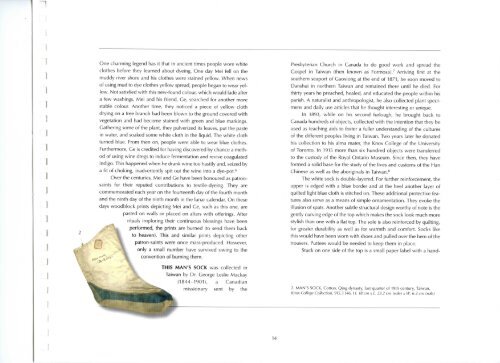Touched by Indigo - Royal Ontario Museum
Touched by Indigo - Royal Ontario Museum
Touched by Indigo - Royal Ontario Museum
Create successful ePaper yourself
Turn your PDF publications into a flip-book with our unique Google optimized e-Paper software.
1<br />
One charming legend has it that in ancient times people wore white<br />
clothes before they learned about dyeing. One day Mei fell on the<br />
muddy river shore and his clothes were stained yellow. When news<br />
of using mud to dye clothes yellow spread, people began to wear yellow.<br />
Not satisfied with this new-found colour, which would fade after<br />
a few washings, Mei and his friend, Ge, searched for another more<br />
stable colour. Another time, they noticed a piece of yellow cloth<br />
drying on a tree branch had been blown to the ground covered with<br />
vegetation and had become stained with green and blue markings.<br />
Gathering some of the plant, they pulverized its leaves, put the paste<br />
in water, and soaked some white cloth in the liquid. The white cloth<br />
turned blue. From then on, people were able to wear blue clothes.<br />
Furthermore, Ge is credited for having discovered <strong>by</strong> chance a method<br />
of using wine dregs to induce fermentation and revive coagulated<br />
indigo. This happened when he drank wine too hastily and, seized <strong>by</strong><br />
a fit of choking, inadvertently spit out the wine into a dye-pot.6<br />
Over the centuries, Mei and Ge have been honoured as patronsaints<br />
for their reputed contributions to textile-dyeing. They are<br />
commemorated each year on the fourteenth day of the fourth month<br />
and the ninth day of the ninth month in the lunar calendar. On these<br />
days woodblock prints depicting Mei and Ge, such as this one, are<br />
pasted on walls or placed on altars with offerings. After<br />
rituals imploring their continuous blessings have been<br />
n<br />
performed, the prints are burned (to send them back<br />
to heaven). This and similar prints depicting other<br />
patron-saints were once mass-produced. However,<br />
only a small number have survived owing to the<br />
convention of burning them.<br />
THIS MAN'S SOCK was collected in<br />
Taiwan <strong>by</strong> Dr. George Leslie Mackay<br />
(1844-1901), a Canadian<br />
missionary sent <strong>by</strong> the<br />
Pres<strong>by</strong>terian Church in Canada to do good work and spread the<br />
Gospel in Taiwan (then known as Formosa).7 Arriving first at the<br />
southern seaport of Gaoxiong at the end of 1871, he soon moved to<br />
Danshui in northern Taiwan and remained there until he died. For<br />
thirty years he preached, healed, and educated the people within his<br />
parish. A naturalist and anthropologist, he also collected plant specimens<br />
and daily use articles that he thought interesting or unique.<br />
In 1893, while on his second furlough, he brought back to<br />
Canada hundreds of objects, collected with the intention that they be<br />
used as teaching aids to foster a fuller understanding of the cultures<br />
of the different peoples living in Taiwan. Two years later he donated<br />
his collection to his alma mater, the Knox College of the University<br />
of Toronto. In 1915 more than six hundred objects were transferred<br />
to the custody of the <strong>Royal</strong> <strong>Ontario</strong> <strong>Museum</strong>. Since then, they have<br />
formed a solid base for the study of the lives and customs of the Han<br />
Chinese as well as the aboriginals in Taiwan.8<br />
The white sock is double-layered. For further reinforcement, the<br />
upper is edged with a blue border and at the heel another layer of<br />
quilted light blue cloth is stitched on. These additional protective features<br />
also serve as a means of simple ornamentation. They evoke the<br />
illusion of spats. Another subtle structural design worthy of note is the<br />
gently curving edge of the top which makes the sock look much more<br />
stylish than one with a flat top. The sole is also reinforced <strong>by</strong> quilting,<br />
for greater durability as well as for warmth and comfort. Socks like<br />
this would have been worn with shoes and pulled over the hem of the<br />
trousers. Puttees would be needed to keep them in place.<br />
Stuck on one side of the top is a small paper label with a hand-<br />
2. MAN'S SOCK, Cotton, Qing dynasty, last quarter of 19th century, Taiwan,<br />
Knox College Collection, 915.3.146, H. 18 cm x L 23.2 cm (sole) x W. 6.2 cm (sole)<br />
14
















